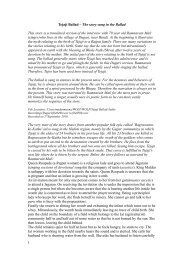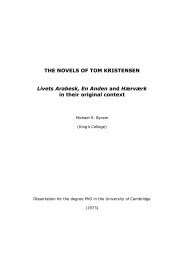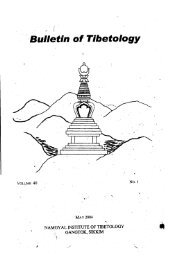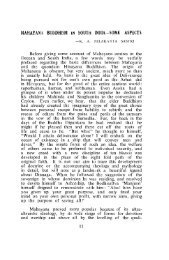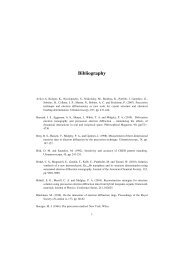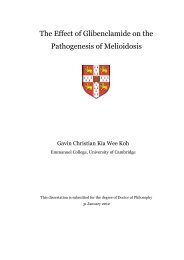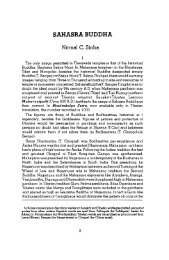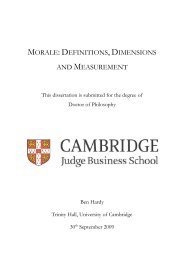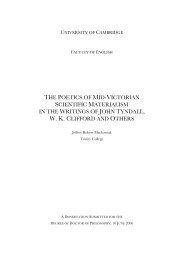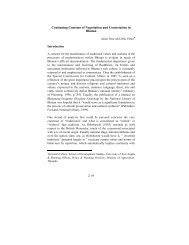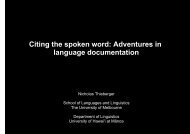The Crusades, the Genoese and the Latin East - DSpace at ...
The Crusades, the Genoese and the Latin East - DSpace at ...
The Crusades, the Genoese and the Latin East - DSpace at ...
Create successful ePaper yourself
Turn your PDF publications into a flip-book with our unique Google optimized e-Paper software.
`perhaps most notable for its h<strong>and</strong>some baptistery with its wonderful repertory of decor<strong>at</strong>ive<br />
sculpture on <strong>the</strong> arches <strong>and</strong> hood moldings: Arab godroons on <strong>the</strong> north side, cornices <strong>and</strong><br />
modillions reminiscent of Roman architecture <strong>and</strong> western Romanesque ornament paralleled by<br />
French sculpture. '434 <strong>The</strong> ca<strong>the</strong>dral <strong>and</strong> <strong>the</strong> baptistery suggest th<strong>at</strong> <strong>the</strong> ruling family of Gibelet<br />
was not merely interested in <strong>the</strong> defence of <strong>the</strong>ir town or <strong>the</strong> commercial revenues, but had made<br />
a clear <strong>at</strong>tempt to design it in an impressive manner. Apparently, despite <strong>the</strong> fact th<strong>at</strong> Genoa never<br />
seemed to have raised money from Gibelet, <strong>the</strong> Embriaci who lived <strong>the</strong>re had enough capital to<br />
spend in <strong>the</strong>ir small town.<br />
<strong>The</strong> nineteenth-century map of Gibelet by Renan is a useful piece of evidence as long as<br />
<strong>the</strong>re are no excav<strong>at</strong>ion reports available. <strong>The</strong> reason th<strong>at</strong> Renan's account <strong>and</strong> map are so<br />
valuable is because, as Nina Jidejian described historical Gibelet: `with <strong>the</strong> departure of <strong>the</strong><br />
crusaders Jebeil sank into obscurity. '435<br />
It is interesting to notice <strong>the</strong> four churches marked by<br />
Renan as well as <strong>the</strong> Khan, near <strong>the</strong> main l<strong>and</strong> g<strong>at</strong>e according to his plan of <strong>the</strong> sea-port town<br />
(Figure 6). <strong>The</strong> Embriaci are responsible for <strong>the</strong> reconstruction of most of this town, including <strong>the</strong><br />
ca<strong>the</strong>dral, most of <strong>the</strong> walls <strong>and</strong> towers (especially on <strong>the</strong> nor<strong>the</strong>rn side) <strong>and</strong> <strong>the</strong> castle.<br />
Importantly, <strong>the</strong> family must have invested much of its resources in <strong>the</strong>se constructions <strong>and</strong> l<strong>at</strong>er<br />
<strong>the</strong> reconstructions of <strong>the</strong> damaged parts. It would be interesting to fur<strong>the</strong>r examine <strong>the</strong> remains<br />
of <strong>the</strong> medieval town to examine if <strong>the</strong>re were any remains of commercial structures built in<br />
town, such as loggia orfondaco, custom houses, equivalent to <strong>the</strong> fonde by <strong>the</strong> l<strong>and</strong> g<strong>at</strong>e <strong>and</strong> <strong>the</strong><br />
chaine near <strong>the</strong> port, as in Tyre <strong>and</strong> Acre. <strong>The</strong>se structures would have been necessary in order to<br />
accommod<strong>at</strong>e <strong>the</strong> travelling merchants <strong>and</strong> for local bureaucracy. Wilbr<strong>and</strong> of Oldenbourg wrote<br />
about <strong>the</strong> small port of Gibelet: 'portum habet paruis nauibus saris commodum, raro<br />
frequent<strong>at</strong>um, quia eius tanquam `pauperis est numerare pecus",, a36 However, an examin<strong>at</strong>ion<br />
of such buildings, if <strong>the</strong>y existed, might be useful for <strong>the</strong> estim<strong>at</strong>ion of <strong>the</strong> measure of commerce<br />
th<strong>at</strong> crossed through town <strong>and</strong> how much Italian influence can be identified in <strong>the</strong> urban structure<br />
of this special crusader <strong>and</strong> <strong>Genoese</strong><br />
town.<br />
Hugh de Biblio<br />
Gerald Day wrote about <strong>the</strong> Embriaco family in <strong>the</strong> <strong>L<strong>at</strong>in</strong> <strong>East</strong> th<strong>at</strong> `<strong>the</strong> role... of <strong>the</strong> Embriaco<br />
family in <strong>the</strong> crusading st<strong>at</strong>es, where th<strong>at</strong> family, with all <strong>Genoese</strong> property enfoeffed to <strong>the</strong>m,<br />
433<br />
Enlart, text, vol. 2, p. 123.<br />
434<br />
Folda, <strong>The</strong> Art, pp. 70-2.<br />
435<br />
Nina Jidejian, Byblos through <strong>the</strong> Ages, p.<br />
436 Wilbr<strong>and</strong> of Oldenburg Peregrin<strong>at</strong>io, p. 167.<br />
124



